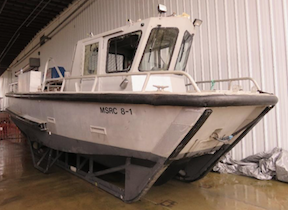
The following is a marine accident brief from the National Transportation Safety Board (NTSB):
(WASHINGTON) — About 1038 local time on Jan. 16, 2019, the workboat MSRC 8-1, which operated from the oil spill response vessel (OSRV) Louisiana Responder, capsized during an oil spill boom deployment exercise in the Lower Mississippi River near Boothville, La. (mile 18), trapping both of its crew inside. While the OSRV’s crew and the U.S. Coast Guard worked to rescue the trapped MSRC 8-1 crew, the boat sank. One crewmember died in the sinking; the other crewmember was not found and is presumed dead. MSRC 8-1 was declared a constructive total loss with damage estimated at $250,000. A sheen of oil was sighted on the water after the vessel sank; no other pollution was reported.
Probable cause
The National Transportation Safety Board determines the probable cause of the capsizing of the workboat MSRC 8-1 was the boat becoming perpendicular to a strong river current, for an undetermined reason, while tethered to Louisiana Responder. Contributing to the accident was the unforeseen risk associated with conducting the exercise in a strong current, which also contributed to the severity of the outcome by hampering rescue efforts.
Analysis excerpt
The H-bitt on MSRC 8-1 was located just aft of midship above the vessel’s center of gravity, and the boom towline was made up to the top of the bitt. Once MSRC 8-1 was perpendicular to the current, the boom towline was tending directly off the boat’s port side from the H-bitt with tension on it. The vessel’s operating manual noted that the vessel was at risk of capsizing with a towline tending as little as 10 degrees off centerline dead astern. By comparison, during the accident, the boom towline was tending about 90 degrees off centerline. The static force that the boom towline exerted on the H-bitt, combined with the force of the current broadside to MSRC 8-1’s underwater hull, attached framework, and large rudders, created a heeling moment, which rolled the boat to port quickly, overcoming its inherent stability and capsizing it. Although the boom towline was rigged for ease of release, the speed of the capsizing and the tension on the line likely prevented the crew from releasing it.
Click here to read the complete report.
